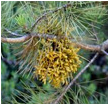
By Mark Gutglueck
Because of its association with Christmas, mistletoe has a benign reputation. It is, however, a malignant parasite that represents a danger to many of our region’s pine trees, including Jeffrey Pine, Ponderosa Pine, and Coulter Pine.
Dwarf mistletoe, Arceuthobium campylopodum, is native to the low to moderate elevation coniferous forests of western North America, including those in San Bernardino County. Dwarf mistletoe is a greenish-yellow structure above the bark of the tree, while most of the plant is beneath the bark. Seeds mature during the fall and disperse to nearby trees.
Dwarf mistletoe is dioecious, with individual plants being either male or female. Its fruit will build up hydrostatic pressure internally when ripe and shoot the single sticky seed at a speed of nearly 50 miles per hour. This is one of the rare examples of the phenomenon of rapid plant movement.
Dwarf mistletoe seeds are enveloped in a hygroscopic, glue-like substance called viscin. They spread if they land on a suitable host’s shoot. Due to gravity, each succeeding planting starts lower than the level it sprang or shot from.
Western dwarf mistletoe is also called ponderosa pine dwarf mistletoe and it infests at least 15 percent of the ponderosa-Jeffrey pine type in the local environs. Infected trees almost assuredly experience growth loss and wood quality reduction. They can further suffer premature death. Infected tree can also see reduced seed and cone development.
Dwarf mistletoes have a root-like parasitic system that use primary and secondary appendages to invade with only minimal injury the tree’s xylem, which transfers water from the roots to the leaves, the tree’s phloem, which transfers sugar made from photosynthesis or other nutrients to various parts of the tree. The mistletoe’s root system does not sink into the soil, but rather into the tree, and thus serves to dehydrate the tree as it takes water for itself. Mistletoe has some chlorophyll of its own, but far less than a tree, so it is also depletes its host tree of nutrients, sucrose and minerals.
Trees infested with mistletoe often have branches that look like witches’ brooms.

